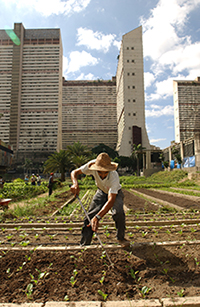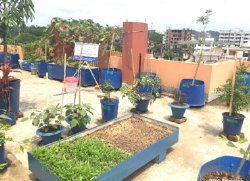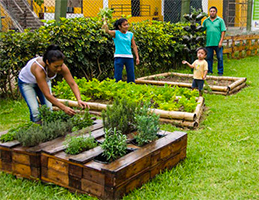System Operations: Resilient and Regenerative Cities
Taking Action for Resilient and Regenerative Cities
The world is becoming more urbanized. It is estimated that 55 percent of the world’s population resides in urban areas and by 2050, the number is expected to increase to 68 percent globally. The developing world has some of the largest and most crowded slums worldwide. Most of the fastest growing cities are found in low-income countries in Asia and Africa alone. Rapid urbanization and population growth come with dietary shifts, changes in demand for food, energy and water, which can further aggravate the already existing stress on natural resources. The capacity of cities to meet the needs of urban populations is currently being tested under the pandemic. To make cities more resilient, the transition towards greener and regenerative cities is becoming essential (see composting and waste-to-resource pages).
Benefits of Growing Greener Cities

Maintaining healthy food value chains and having more green spaces in urban and peri-urban areas are essential to making cities more resilient under COVID-19. Urban agriculture is already practiced by more than 800 million people worldwide already. There are various benefits to urban and peri-urban agriculture including the shortening of supply chains, the increase in availability of fresh produce, and promoting more healthy dietary lifestyles and local economic opportunities. Urban and peri-urban agriculture such as rooftop gardens have various environmental benefits including the reduction of energy and water demand, improvement of air quality, capturing of rainwater and reduction of storm water runoff and discharge as well as a lowering of the urban heat island effect. In addition, the increased presence of urban and peri-urban agriculture makes cities more food secure and self-reliant in the event of an unexpected shock. They also have multiple benefits on human health including mental health, which is essential to human coping capacity during the pandemic.
Accelerating Support to Cities During COVID-19
Support to national governments and local city planning in shifting towards greener and regenerative cities system can be carried out through:
- Accelerating digital transformation by providing geospatial technologies to identify hotspots of vulnerability (e.g. presence of high contagion rates and/or waterborne and foodborne diseases) in urban areas;
- Facilitate access to data and information about the status of environmental conditions in urban and peri-urban areas impacted by the pandemic worldwide in support to greening and resilience plans;
- Supporting nature-based-solutions as well as urban and peri-urban horticulture and the adoption of sustainable land, soil and water management practices.
Case Studies

Enhancing Urban Horticulture Production in Bangladesh
Bangladesh has high urbanization rates with growing concern on unsustainable natural resources management, atmospheric pollution and high poverty rates. The FAO Rooftop Gardening project (2015-2017) in Bangladesh, contributed to food security and the greening of the densely populated cities of Dhaka, the capital, and Chittagong where 250 demonstration rooftop gardens were established (see Figure 1). Urban households received inputs and a total of 800 city dwellers were trained on sustainable rooftop garden technologies through the establishment of gardens. The results of the project were positive and saw an increase in the production of fresh and nutritious vegetables and fruits. The project contributed to generating local income opportunities and increased food security as well as empowering women given that they are assigned the gardening activities in a household.
More info: www.fao.org/3/ca4545en/ca4545en.pdf

Greening infrastructure to address water security in Lima, Peru
An FAO publication Nature-Based Solutions for agricultural water management and food security mentions a greening cities initiative in Lima, Peru - the fifth largest city in Latin America, and fastest-growing desert city after Cairo. The city’s inhabitants saw increasing pressure on natural resources and unsustainable growing patterns in urban and peri-urban areas. To address this, Lima’s Municipal Council adopted regulation to promote urban agriculture in 2012 and the government adopted a law on ‘Mechanism for Ecosystem Services Compensation’ in 2015. Local communities, governments, industries and NGO’s in Lima launched a multi-sectoral platform to promote sustainable use of natural resources while Lima’s water authority is developing a green infrastructure master plan to enhance and complement grey infrastructure. FAO has provided support in the efforts to enhance urban agriculture by establishing a school garden used by students where lettuce, beet, carrots and broccoli are grown therefore increasing food security. For more information see: http://www.fao.org/3/CA2525EN/ca2525en.pdf and http://www.fao.org/ag/agp/greenercities/en/GGCLAC/lima.html
For more info please contact:

